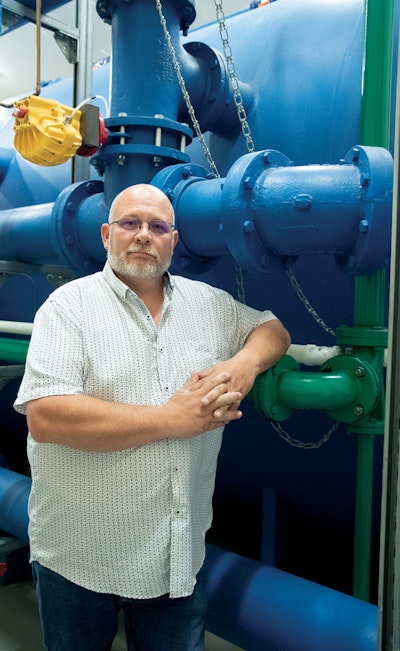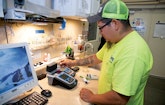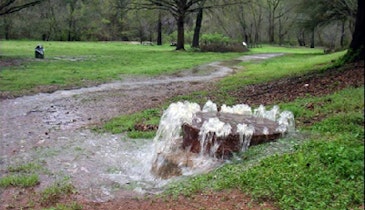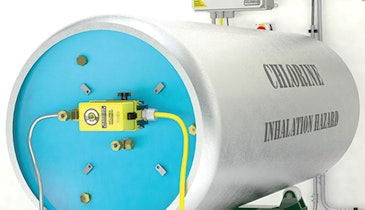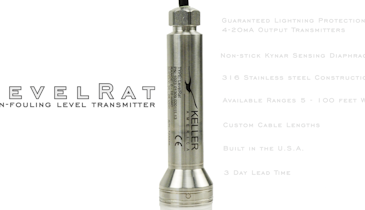
The team at the Rome Water Utility includes, from left, Cody Knoblock, operator; Joe Solis, operator; Chad Ziegler, utility director; and Roberta “Robbie” Schaub-Ruemler, accountant and office manager.
Interested in Treatment?
Get Treatment articles, news and videos right in your inbox! Sign up now.
Treatment + Get AlertsIn 2006 Chad Ziegler inherited a small water utility that had just changed from private to public ownership – and one with a variety of problems that needed solutions.
At the time Ziegler became its director, the newly designated Rome Water Utility in central Wisconsin had two old wells high in nitrates and a newer well with water containing iron and manganese that caused color, taste and odor issues. There were also problems with dead ends in the distribution system, a flat-rate billing system with no customer water meters, and more.
Today, 15 years later, the utility is on a firm footing with two wells, an efficient iron and manganese removal system, new ultrasonic meters in the homes and an automated meter reading system. The utility was recognized with a 2019 Small System Excellence Award from the Wisconsin Section AWWA.
In presenting the award the AWWA section observed, “Chad Ziegler does an excellent job of operating the utility and implementing programs to keep it running effectively and efficiently. … Ziegler does an excellent job of diagnosing problems early and implementing solutions before the situation becomes a crisis. He also helps neighboring systems when they need operational assistance. Rome Water Utility exemplifies what a small water system should strive to be.”
Serving a lake community
What is now the Rome Water Utility began as a private utility serving properties around Lake Camelot, a 393-acre manmade lake in Adams County. There are similar developments around nearby man-made lakes Sherwood (215 acres) and Arrowhead (295 acres).
Lake Camelot was created in the early 1960s and is surrounded by 1,875 half-acre parcels. About 1,200 lots have homes, most of them seasonal. About 400 are used as campsites, and the rest are vacant. The occupied lots have septic systems.
The Rome utility serves about 1,400 connections around the lake, along with Rome Town Center, home to a few businesses and apartment buildings. The two wells can pump up to 1 mgd; the average flow of 350,000 to 400,000 gpd during the peak season drops to about 50,000 gpd in winter. The water tower holds 250,000 gallons.
Originally the system was owned by the Lake Camelot Property Owners Association. “They had one well, a booster pump and a storage reservoir,” says Ziegler. “That fed the system through the late 1980s. Then Well 1 started developing nitrates, and so they drilled Well 2 in 1990. By 1999, both wells had nitrates.” The likely source of nitrates was a nearby farm; nitrates from fertilizer could leach easily through the area’s sandy soil.
“They were looking to drill a third well,” Ziegler says. “Then the DNR [Department of Natural Resources] was concerned because their two wells only had a manual backup generator; if they lost power, they lost pressure to the system. So the DNR wanted a stand tower. In 2000, they drilled Well 3. In 2002-03 they built the water tower.”
In 2004, the Town of Rome bought the system for one dollar and made it a municipal water system. A key reason for the sale was to gain access to the low-bonding interest rates available to municipal entities.
Boosting quality
Ziegler came on board in 2006. He kept wells 1 and 2 on standby, hoping to find a way to deal with the nitrates, but found the remedies too costly. As an interim measure, he mixed water from Well 1 and Well 3 to dilute the nitrates, until Well 4 came online in 2007.
However, the water from wells 3 and 4 (each 650 gpm capacity) were high in iron (0.7 to 1.0 ppm) and manganese (1.6 to 2 ppm): “People would see a lot of black coming around their faucets, and toilets would start turning red.”
The solution was a removal system (Evoqua Water Technologies) based on media filtration, installed in 2006. The well water is dosed with sodium permanganate to precipitate the iron and manganese ahead of the filter, which has four cells with anthracite, gravel and sand media. The filter is backwashed on a timed basis using raw well water. The filtered water contains about 0.01 ppm manganese and essentially zero iron.
“The filter has done wonders,” Ziegler says. “On the day I started here, which was Jan. 21, 2006, I got a phone call from a neighbor who had me come over. He said, ‘What are you going to do with this water quality?’
“He started his washing machine, and it was red — just iron, iron, iron. In that year we would get at least five people a week complaining.” Today, such complaints are rare: “We still get a little bit through because there’s a lot inside of our old mains. We do flushing twice a year to make sure we get out as much as we can.
“Fifteen years ago, you would go to a hydrant to flush it, open it up as fast as it would go, and then slow it down a little bit. You would sit there for two hours before it cleared up. Today, sometimes five minutes and you’re done.”
Before distribution, the filtered water is dosed with fluoride. AQUA MAG blended polyphosphate (Carus Corp.) is added to maintain a protective coating on the pipe interiors and prevent copper leaching; chloramine is added for disinfection. “Because we have the lake across the street, we noticed a lot of organics eating up our chlorine residual,” Ziegler says, “so in 2013 we changed over from free chlorine to chloramines.”
Ever improving
Tackling challenges is a way of life for Ziegler and team members Joe Solis, operator, and Roberta “Robbie” Schaub-Ruemler, accountant and office manager. (Team members George Treul and Kathy Doods retired in 2020 after 15 years of service.)
“Our challenges really started in the beginning,” says Ziegler. “There was very little money. There were no meters, just one set rate. Between 2006 and early 2007 we installed 1,100 meters. That helped us try to find more water leaks.
“Our issue then was that we still had unlimited use for campers; they didn’t have to have meters, but still we narrowed it down. When I started we were pumping probably 500,000 gpd. Now it’s 350,000 to 400,000 gpd. People conserve a bit more when usage is not unlimited.”
Another issue is dead ends in the distribution system, largely because many of the properties surround cul de sacs. “When I started there were 84 dead ends,” says Ziegler. “We did a looping project in 2007 around the outskirts of the system. Now we’re down to 42 dead ends and there is more free flow.”
Water main sizing is an additional concern: about 95% of the system consists of 3-inch mains. “You don’t get a lot of velocity or flow out of 3-inch water mains,” says Ziegler. “Back in the 1960s, 1970s and 1980s, there weren’t a lot of homes yet, and so water pressure was never an issue. Today it gets to be a little bit of an issue.
“People don’t notice it so much because of the looping projects we did, but if everybody was here during the week and they all flushed the toilet at the same time, they would notice a pressure loss.”
Those three-inch mains of transite concrete pipe are also swelling in places where the pipes lie below the water table. “We’ve got 3 to 5 feet of groundwater above our mains in some places,” says Ziegler. “Some of those mains are 4.2 inches now. They’re starting to become really oversized. Right now we don’t have a lot of breaks or leaks, but I have a feeling that will be coming soon, as much as they are swelling up.”
Detecting leaks
Leak detection is difficult in an area where, Ziegler says, “You could dig to China through pure sand. Leaks don’t surface very quickly. I watch my SCADA system closely. I can tell when a hydrant is opened up. I measure my nighttime flow between midnight and 4 a.m. I look at it periodically through the week to see if we’re using the same amount of water during that time.
“Once my usage starts to go up, I know there’s an issue. Finding it still is a problem. Leak detection companies have come in, and it’s tough for them because unlike a normal city, we don’t have a valve and a hydrant at every corner.” The utility’s automated meter reading system does help quickly detect leaks within homes.
Meanwhile, the utility has a strong financial position; a Safe Drinking Water Loan for the main building, Well 4 and the 2007 looping project will be paid off in 2027. “We’re talking about expansion and we’re also talking about replacing some of the water mains that are getting so big before we do have an issue,” Ziegler says.
“This is a very unique water system. We’ve done pretty well over the last 10 years getting our system back in order. We’re starting to add valves in different places. We’re adding some flushing hydrants to areas that have dead end problems and flushing problems.
“One thing I stress the most with my team is cleanliness, especially at the well houses. If somebody walks into a well house and it’s totally dirty, that reflects on your water utility.”
“This has been a great career. It has been challenging for the way this utility was developed. I still believe there’s only one job better than mine — testing fishing lures.”
